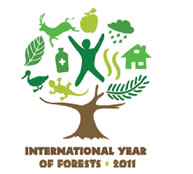
|
2011 International
Year of Forests
Marking the launch of the International Year of Forests
by the United Nations Forum on Forests (UNFF9) in
New York on 29 January, Dennis Garrity, the Director
General of the World Agroforestry Centre, highlighted
the importance of mixing trees with agriculture. "Over
a billion hectares of agricultural land, almost half of the
world's farmland, have more than 10 percent of their area
occupied by trees," said Garrity, "and 160 million hectares
have more than 50 percent tree cover."
Later, speaking at the High Level Dialogue of UNFF9 on
3 February 2011, Garrity said, "Agroforestry is a crucial bridge between forestry and agriculture. Essentially,
agroforestry is about the role of working trees in
agricultural landscapes, particularly on, but not limited to,
small-scale farms."
Adopting the slogan "Working trees that keep on giving," the Centre worked to integrate activities to celebrate the
Year into its communications programme. The Centre
participated actively with the Collaborative Partnership
on Forests (CPF - www.fao.org/forestry/cpf/en/), which
is a voluntary arrangement among 14 international
organizations and secretariats with substantial programmes on forests. Each month, several of the
partners took the lead on developing and issuing a press
release dealing with a particular aspect of forests. With
the UN imprimatur, these statements featured widely in
the world media. World Agroforestry contributed to most
of the statements, and worked actively to develop those
concerned with "Forests for People: Community-based
Forest Management" and "Forests, Food Security and
Agriculture."
Another element in the public awareness strategy was
an intensified effort throughout the Year to place stories
about the impact of Centre research with major media
outlets at least once a month. A typical example was
a story entitled "Why farming with trees boosts climate
security" by the Reuters news agency (see www.trust.
org/alertnet/news/expert-views-why-farming-with-trees-isclimate-
security).
The Communications Unit developed an exhibition
entitled "Working trees that keep on giving: an exhibition
demonstrating the power of agroforestry, trees on
farms and in the landscape." This display consisted of
30 panels with colourful photographs and simple text
explaining aspects of agroforestry. As a way of quickly
highlighting the value of agroforestry to new audiences,
the exhibition was shown at a number of major
international meetings throughout the Year, including the
World Bank Investment Forum in Nairobi, Kenya, the
FAO-sponsored First Drylands Week in Dakar, Senegal, the University of Leeds, UK meeting on "Food security,
Health and Impact Knowledge Brokering," and the 10th
Conference of the Parties of the UN Convention to
Combat Desertification, in Changwon, Republic of Korea.
Bringing the subject to a much wider audience in the
Centre's host country, the exhibition was also placed
in the National Museum of Kenya in Nairobi, for the
months of July and August. During this time, as well as
the usual stream of visitors, a series of groups of Kenya
schoolchildren were shown the display and involved in
school activities related to agroforestry.
In another sort of public awareness initiative, the
BusyTrees campaign was launched at the Glastonbury
Rock festival in the UK by Scriptoria Communications on
behalf of World Agroforestry. Featuring several dedicated
websites (busytrees.com and treesonfarms.com), the
campaign uses cartoon characters, a petition, social
media sites and public engagement to spread the word
about agroforestry to the general public.
"The International Year of Forests is a momentous
opportunity to more fully recognize the tremendous
importance of agroforestry and evergreen agriculture in
building a better world," noted Garrity. "Agroforestry is
one of mankind's best hopes to create a climate smart
agriculture, increase food security, alleviate rural poverty, and achieve truly sustainable development. And, thereby,
better ensure that our world's forests can indeed be
conserved far into the future." |

